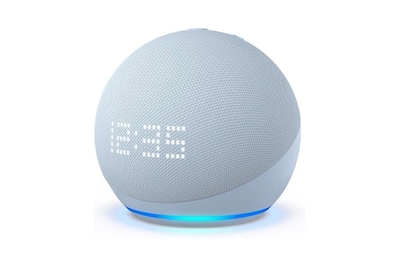
By Jon Chase
Jon Chase is an editor of smart-home coverage. For Wirecutter, he learned how to pick smart locks and shaved a colleague’s head to test hair clippers.
If you have ever been bumping down a country road, belting out your favorite tunes from the car stereo, only to have it turn to angry static the moment you enter a radio-signal-free zone, then you know precisely what it was like to wake up every morning in my bedroom with a crummy old clock radio.
It is a pitiable way to start the day, with NPR updates reduced to a series of broken phrases like in a deranged Mad Libs session, and daggers thrown by your spouse because you insisted on bringing that cursed electronic into her life.
Well, problem solved, relationship healed, we’re gonna live happily ever after.
The Amazon Echo Dot (5th Gen) with clock entered our world, and it’s been a revelation.
At a glance we can check the time without fiddling with anything, because it has a cool retro LED clock. Whatever audio I want to listen to—music, radio, podcasts, news, books—streams in clarion perfection, and it responds in an instant whenever I issue a voice command to the third partner in our marriage (Alexa). Setting an alarm clock involves neither hacking of arcane menus nor button mashing as before.
Rarely has a relationship win been so thoroughly, easily, and affordably achieved.
Our pick
A modern version of a classic bedside clock radio, this Alexa-powered smart speaker streams audio based on your voice commands, while an LED clock displays the time and other data.
Crackly static no more
Unlike a clock radio, which relies on finicky radio waves for a signal, our Echo Dot connects to Wi-Fi, so whatever audio I choose to hear is perfectly clear and always available. We have ours set with a weekday alarm that streams new radio and then automatically shuts off after an hour. And all of our other various audio accounts, both free and paid—Apple Music, Audible, Spotify, TuneIn—are connected to Alexa, so when we ask for music or a radio station, one or another app streams it without our having to think about it.
The only times we’ve had issues are when our home internet has gone down. In that case, though, we still have the option to stream audio from our smartphone to the Echo Dot via Bluetooth. Or, like, talk or whatever.
It does smart-home stuff, if you want

As an editor on the smart-home beat, I am biased, but I love that I can dig into the settings of the Dot and use it for all kinds of non-radio tasks. Alexa is a smart-home platform, which is a fancy way of saying that it can connect all my smart devices so that they all work together. I can issue a voice command to my clock radio to open the shades, for instance, or to turn off all the smart lights downstairs at night (or turn them on if I hear something spooky).
This Dot model also has a built-in sensor that detects motion, so I can set it to trigger another device when someone enters the room—such as telling the shades to drop when someone enters after sundown.
A favorite feature in our household is the ability to “drop in” on another Echo speaker anywhere in the house so we can use it like an intercom. Rather than bellowing to my tween that she needs to come upstairs and clean her room, for instance, I can drop in on the Echo in the kitchen and bellow at her through that speaker, and she can actually hear what my bellowing is all about.
The LED display does more than tell time (if you can see it)
I’m not in love with the Dot’s overall styling, but I’m fond of the LED display, which by default shows the time. You can adjust its brightness, as well as set it to auto-dim in darkness, which is great.
But it sometimes throws up a bit more info that’s fun if not always terribly useful—if you ask for the weather, it speaks the forecast but also displays clouds or sun, the temperature, and expected highs and lows, using its LEDs. Similarly, after you request a song or station, it displays the band, song, call letters, and the like.
The display is not particularly easy to read at a distance, though. While my wife has the visual acuity of a peregrine falcon, mine is closer to that of a mole. If you’re like me, you may find that the only way to read the Echo Dot’s clock without glasses from bed is for it to sit on a bedside table.
It’s easy to use, but you’ll need to get the hang of it
Using any smart speaker involves a modest learning curve, which may be off-putting to some people. For starters, you have to commit to having a device that you talk to sitting in your bedroom. That isn’t actually as big a deal as it may seem—I’d humbly note that if you use a smartphone or computer, both devices collect way more personal data and are far more vulnerable.
The toughest hurdle is simply getting used to summoning and instructing Alexa to get it to do what you want, though Alexa is rather capable at hearing natural, conversational language. For instance, I set up a weekday alarm that goes off at 6:45 and plays my local NPR by saying “Alexa, set a weekday alarm at 6:45 a.m. and play WNYC FM.” You can mix the language up a bunch of different ways, and Alexa usually gets it—and if it’s a particularly exotic command, Alexa may ask you to confirm what it understood to prevent it from doing something wrong. Ultimately that may be the Echo Dot’s most compelling feature: giving me exactly what I want without any static.
This article was edited by Jason Chen and Catherine Kast.
Meet your guide
Jon Chase is an editor leading smart-home coverage at Wirecutter. He has been covering technology as a writer and editor since the days before mobile phones got smart. His work has been featured in various print and online publications, and on television. He currently has over 35 smart devices installed in his home. None of them work perfectly.


